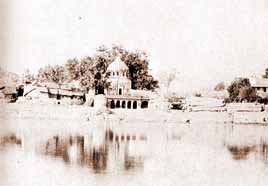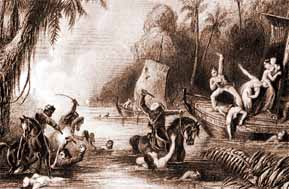

|
It was Cawnpore that came to symbolize the horror of the mutiny for the British and without doubt what transpired there in the summer of 1857 was a major factor in the thirst for vengeance which seemed to drive the British troops as they fought to reverse the mutineers initial successes. Till the end of the mutiny, British troops going forward with the bayonet shouted "Cawnpore! Cawnpore!" as their warcry and punishments meted out to captured mutineers were executed with Cawnpore in mind. Cawnpore was a major crossing point of the Ganges and an important junction
where the Grand Trunk Road and the road from Jhansi to Lucknow crossed.
In 1857 it was garrisoned by four regiments of native infantry and a European
battery of artillery and was commanded by General Sir Hugh Wheeler. Wheeler
had served in India most of his life, had an Indian wife and a gross overconfidence
in the loyalty of the sepoys under his command.
It was then that Nana Sahib, the dispossessed heir to the throne of the Mahrattas, appeared. Years before the British had abolished the title of Peshwa, the last of the great Hindu dynasties and the rulers of the now defunct Mahratta confederacy. Nana Sahib, carrying the Peshwa bloodline, was simply the Maharajah of Bithur, a dusty little statelet not far from Cawnpore. He had been refused a pension by the British and if this had embittered him he took pains not to show it. He came to Cawnpore with his personal guard and offered Wheeler his assisstance. Wheeler declined Nana Sahib's offer to take the English ladies under his protection and instead suggested that Nana Sahib add his men to the guard on Cawnpore's treasury. This he promptly did. In early June Wheeler's informants indicated that a rising was in danger of breaking out at any minute and all the Europeans made for the entrenchment. Almost simultaneously the sepoys rose, released the convicts in the town jail, brushed past Nana Sahib's men, looted the treasury and started down the road to Delhi. Not far from Cawnpore they turned round and came back and soon Nana Sahib was leading them. We do not know if he had been in league with the sepoys from the start or if he simply took an opportunistic chance of recovering his family's past power. His choice, however, would ensure him pride of place in the Victorians' rogues' gallery. Unlike Lucknow, the siege of Cawnpore was not a protracted affair. It lasted just over three weeks, but it took place in June when the Indian sun is at its most merciless. The entrenchment had almost no shade and contained only one serviceable well. This, the only source of water was in an extremely exposed position, covered by enemy fire. Many men died trying to get water. Inside the position were about a thousand Britons, including 300 women and children. Ammunition, at least, was plentiful but the food supply was dangerously small. The mutineers never actually took the place by storm though they made a few half-hearted attacks. They could, however, cover almost every inch of the entrenchment with their muskets and kept up a constant stream of fire into the British position. The British could get no rest and their movement was severely restricted. Still they held on, hoping for relief from Lucknow to the north-east or Allahabad downstream on the Ganges. They waited in vain and every day the number of dead and wounded increased. Some went mad from the heat or the tortures of thirst and when Wheeler's son was killed by a roundshot, the general seemed to give up all hope. On June the 25th Nana Sahib sent a message to Wheeler offering safe conduct to the Ganges for all inside the entrenchment and boats to take them down to Allahabad. The negotiations took place outside the entrenchment on the 27th and Wheeler had little choice but to accept. Though the British in their colonial wars sometimes did fight to the last man, it was usually when they were overrun and had no choice. The women and children, moreover, must have weighed heavily on Wheeler's mind. One last concession he won, however; the British troops would be allowed to take their sidearms and sixty rounds apiece. Nana Sahib sent some elephants and palanquins to assist the British in their ignominious withdrawal. They were followed by a crowd of sepoys and the ubiquitous sightseers that attend any event in India. At the ghat, the steps leading down to the water where Hindus take their ritual baths, a fleet of country boats awaited. Painfully the British loaded the women, children and wounded into the wooden craft. The last man aboard was a Major Vibart, helped up solicitously by the sepoys formely under his command. Barely had his feet touched the deck when things started to go wrong. The Indian boatmen, instead of pushing-off, jumped overboard and made for the shore. The British opened fire on them. Perhaps it was all a terrible mistake, but from prepared positions on the riverbanks the sepoys showered the boats with a storm of grapeshot and musketry. Women screamed, the boats caught fire, the river turned red and corpses floated downstream. Indian cavalry troopers rode into the shallows and slashed at the wounded with their sabres. Only one boat managed to extricate itself and carrying a few survivors drifted away. Days later, after a nightmarish journey, they came across a British outpost upstream from Allahabad and the only four men to escape from Cawnpore found safety. 
Contemporary image of the massacre at Satchiura Ghat in Cawnpore. The surviving men back at what later became known as the 'Massacre Ghat' were immediately put to the sword. The women and children were led away to the aptly named Bibi-Ghar ( the house of the women) a former residence of a British officer's Indian mistress. On July 15th, a group of men, including the town butchers, entered the Bibi-Ghar armed with knives and hatchets and hacked all the women and children to pieces. Their bodies were thrown down a well. When news of the slaughter at the Bibi-Ghar reached Britain, it sent a shiver of horror through the nation. In Victorian Britain women and children had achieved an elevated status and it was a widely held belief that they had a right to special protection. It was during the reign of Victoria that the idea of 'women and children first' in a shipwreck became the norm and parliamentary legislation had ensured that women and children were protected from the worst abuses of the factory system. The seeming treachery of Nana Sahib at the massacre ghat was nought when measured against the unspeakable atrocities of the Bibi-Ghar. Vengeance was required and even more stern-faced than the Old Testament judges of the Bible, the British wanted more than just an eye for an eye and a tooth for a tooth. When the British later pushed up the valley of the Ganges and Cawnpore once more fell into their hands, they took their sepoy prisoners to the Bibi-Ghar and forced them to lick the blood-encrusted floors clean. Then they were taken out and hanged. Regiments newly arrived from Britain were routed through Cawnpore and shown round the site of the massacre. If it was intended to stiffen the troops resolve and harden their hearts against the mutineers it was probably unnecessary. Their hearts were hard enough already.  The Bibighar - House of the Ladies Nana Sahib disappeared to some unknown fate and despite great efforts
the British never captured him. As late as the end of the 19th century
reports would come in that some zealous subaltern in some remote corner
of India had arrested him. They were all cases of mistaken identity though
and his ultimate end remains a mystery.
|